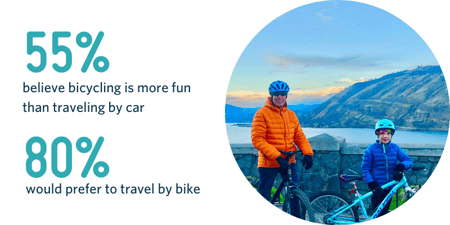Active travel amongst children has long been an interest for many of the organizations and partners Love to Ride works with. While our main campaigns focus on the bike riding behavior of adults, we took a delve into the research world to explore the similarities and challenges of effectively encouraging the youngest populations to build lifelong biking habits from an early age.
Knowing your audience is important
As with any behavior change program, it’s important to be specific about who your target audience is and what behavior you’re trying to impact or change. Our research suggested different age groups are typically impacted by different barriers.
For example, younger children are often more reliant on their parents or primary caregivers taking them to school. A literature review by Lu et al. noted that 48% of studies with statistically significant results reported parental concerns for safety, lack of time, and ease of dropping children off on the way to work were key barriers limiting childhood active travel.
With older age groups, social norms can be more impactful than parents’ perceptions of cycling. In Underwood and Handy’s (2012) study, 39% of adolescents noted that bikes were ‘uncool’ and described bicycling with negative associations.

Similarly, differences amongst gender and ages should also impact program design. Somerset and Hoare (2018) found adolescent girls self-identified barriers to engagement in physical activity by citing conforming to gender stereotypes, boys dominating sport, embarrassment, and lack of support.
A desire to travel actively
On the whole, children understand the benefits and, particularly younger children, see riding a bike as a fun activity which you can do with friends.
55% of children state that bicycling is more fun than traveling by car and 80% would prefer to go by bike (Cycle England, 2009). Half of secondary and high school students indicated having friends to ride with was important (Mackie, 2009).

Living Streets have noted research that found children view the journey to and from school as one of their most important social activities describing them as “intense, loved, vital, playful, social experiences…central to friendships”. They go on to say how children may often feel that the journey, and what children did as they traveled, was equally as important as the destination.
Parents hold the keys to the bike shed
Throughout our research we found parents play a key role in encouraging and supporting their children to ride. A lack of confidence surrounding bike riding, for themselves and for their children, leads to a less active school commute.
Time restraints are a prevalent barrier, we see this in our own data from Cycle September 2021. 5% of registrants who stated ‘other’ when asked about their barriers to bike riding more often or to work, provided an answer referencing children or school.
Other research suggests when parents have few concerns, children are five times more likely to walk to school.
Where are we now?
Our early findings are not conclusive of an entire population, nor do they recognize every situation, view, or population group. Whilst parental concerns, social norms, and motivations do play a key role within active travel amongst children, it is important to acknowledge there are a number of socio-economic, cultural, and environmental factors which are more prevalent for some communities than others. What we have concluded is the need for truly collaborative and holistic approaches when designing and evaluating active travel initiatives for children.
Want to join us?
We've recently had an uptick in requests from our clients for us to apply our behavior change approach to school-aged children. If you're also interested in having a comprehensive behavior change program focusing on children, parents and school staff, we'd love to hear from you. We're also interested in talking with anyone working with school-aged children on active travel. Please do get in touch using the form below or via email to hello@lovetoride.net
References:
Lu, W., McKyer, E.L.J., Lee, C. et al. Perceived barriers to children’s active commuting to school: a systematic review of empirical, methodological and theoretical evidence. Int J Behav Nutr Phys Act 11, 140 (2014). https://doi.org/10.1186/s12966-014-0140-x
https://escholarship.org/content/qt993019hq/qt993019hq_noSplash_76752227a9ed63b75710330d5751f23e.pdf
Somerset, S., Hoare, D.J. Barriers to voluntary participation in sport for children: a systematic review. BMC Pediatr 18, 47 (2018). https://doi.org/10.1186/s12887-018-1014-1
https://road.cc/content/news/3641-parents-safety-concerns-main-barrier-children-cycling-school
https://www.australasiantransportresearchforum.org.au/sites/default/files/2009_Mackie.pdf
https://www.livingstreets.org.uk/news-and-blog/blog/how-do-we-create-safer-routes-to-school
Privacy policy
All rights reserved. Copyright 2021